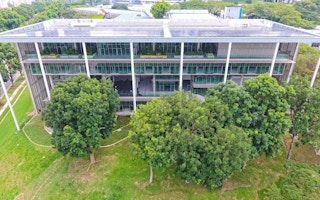The National University of Singapore has built its first net-zero building on campus, making it also the first of its kind in Singapore to be built from scratch.
To continue reading, subscribe to Eco‑Business.
There's something for everyone. We offer a range of subscription plans.
- Access our stories and receive our Insights Weekly newsletter with the free EB Member plan.
- Unlock unlimited access to our content and archive with EB Circle.
- Publish your content with EB Premium.
Launched at the new School of Design and Environment (SDE), SDE 4 is the latest addition to the three buildings that exist in the school, but the only one currently equipped with sustainable building designs such as solar roof installations, a hybrid cooling system as well as innovative approaches to optimise natural ventilation and lighting.
Being net-zero also means that the building produces more energy than it consumes, which it does with a “solar farm” on its roof, comprised of more than 1200 solar photovoltaic panels. The building draws energy from the university power grid on days when there is insufficient sunlight.
The building’s green infrastructure further includes a large overhanging roof, together with east and west facades, to provide a cooler interior. Its hybrid cooling system also ensures rooms are supplied with cool air at higher temperatures and humidity levels than a conventional air-conditioning system, ensuring that they are not overly cooled.
“SDE 4 offers valuable lessons to future generations for the design of self-sustainable buildings,” said Professor Tan Eng Chye, at the opening of SDE 4. “It sets an example to the building industry for higher performance standards and the integration of renewable technologies.”
Minister for Finance and chairman of the National Research Foundation, Heng Swee Keat, who visited the building’s new facilities on Wednesday, said, “We have made green buildings a priority to climate change,” noting that Singapore’s building sector accounted for a quarter of the country’s carbon emissions.
“Ultimately, our buildings must be more than just bricks and mortar,” Heng added. “They must be human-centric and help to promote interactions among their occupants and connect them and improve wellness.”
Health and well-being is an integral part of SDE 4, according to Professor Tan, who revealed that the combination of natural and mechanical ventilation, air-conditioning and a hybrid system supplemented by ceiling fans ensures that fresh air is continuously delivered to building occupants.
SDE 4 also boosts human comfort and well-being by integrating natural elements into its environment that “offer uninterrupted views to greenery, visibility of water systems and access to daylight.”
The building is on its way to being awarded a WELL certification by the International WELL Building Institute, a certification that recognises best practices in design and construction alongside a human-centric approach that promotes occupant health and wellness.
Professor Lam Khee Poh, dean of the SDE, said: “Today, with 90 per cent of our time spent indoors, it is important to study how these environments can contribute to work productivity and health, therefore wellness is the logical next step in the smart building movement.”








